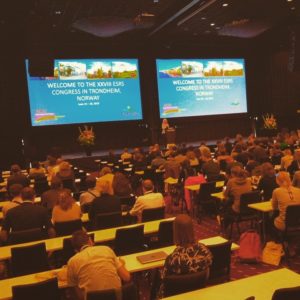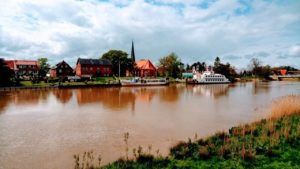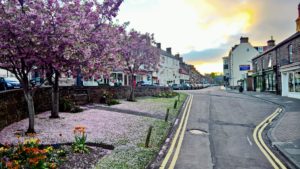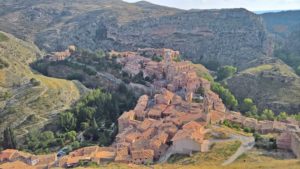In his current research, LDnet board member, Alistair Adam-Hernández examines why some rural communities are able to adapt to change better than others. During the European Rural Sociology Conference 2019, “Rural Futures in a Complex World” in Trondheim (NO), an international group of social scientists discussed how this concept could enable rural communities to harness knowledge and deal with change.

Can the concept of resilience (ability to resist and adapt) explain why some villages adapt to change and develop in a positive way better than others, despite adverse circumstances? What does it mean to be a resilient village? What qualities does it have as such and how can these be fostered? Adam-Hernández addresses these questions in his doctoral thesis and has concentrated in particular on three villages: on the northern German village of Oberndorf an der Oste in the Rural District of Cuxhaven, on Wooler in the English county of Northumberland and on Albarracín in the north-eastern Spanish province of Teruel. After his stays in the villages, the first conclusions can be drawn about what makes these villages resilient: they carry out projects of considerable complexity, make use of the skills of local citizens, apply entrepreneurial approaches and take risks.
Research into resilience has traditionally been deeply rooted in disciplines such as psychology and social ecology. Adam-Hernández has developed his own model of village resilience based on existing findings from these disciplines, as well as from community development. In his view, resilience means successfully managing a disturbance to the existing system. From the point of view of a village community, this means that a difficult situation is first recognised as such and analysed, and that people reflect on their own lives and their future in the locality and then act as a consequence. “What interests me about resilience is a certain ‘perspective of everyday life’ ”, says Adam-Hernández. “It’s about whether a place is perceived from inside and outside as being thriving, dynamic and active. My topic is not to identify resilience, for example, to environmental disasters, nor is it about looking at a place, for instance, during and after a large local employer ups and leaves. With Oberndorf, Wooler and Albarracín, I have selected practical examples that demonstrably have structures, organisations and measures or projects through which the village community tries to actively steer and shape change processes.”

Recently at the 28th Congress of the European Society for Rural Sociology in Trondheim, Norway, he led a working group on the Resilience of Rural Communities together with other researchers from the James Hutton Institute (Scotland), from the Institute for Action Research & the University of Limerick (Ireland). Among other things, colleagues from other nations presented their research, for example a comparison of the two Alpine communities of Obergurgl and Vent in Austria or the perceptions of resilience by young people in the two Irish communities of Duhallow and Lee Valley. Other examples were the Greek island of Amorgos which successfully opposed wind energy planning or the situation in three communities in Australia dependent on cotton.
The working group set out to outline and share tangible tools to assess rural community resilience and produce usable knowledge concerning the contested concept of resilience whilst seeking to understand social and spatial justice dimensions. Sensitive questions were also addressed: can researchers influence how this concept might be utilized to empower communities to tackle change or to make those communities responsible for their own development? Can the resilience concept help to address global sustainability goals by scaling up local insights for transformation gained through place-based research?
In Trondheim Adam-Hernández also presented “his” villages, Oberndorf, Wooler and Albarracín. What do these villages have in common? All three are on the periphery, struggling with problems such as structural weakness, demographic change (ie: the emigration of young people and an ageing population), their distance from key regional conurbations and preserving jobs.
“Collective coalitions for change”
In all three villages there are organisations that are actively involved in village development and maintain the attractiveness – and possibly resilience – of the locality, despite all adversities. These organisations represent different forms of “collective coalitions for change”. What also stands out is the entrepreneurial approach of these organisations and people. The active people appreciate the risk and also take that risk – they are able to act accordingly. The coalitions carry out highly complex projects and use the skills of the local citizens to implement them successfully. This takes place through formal admission into the organisation, by hiring outside experts or, more commonly, through volunteer activities. These places are particularly successful because they actively recruit people who can contribute to the community projects in some way.
Can this development be reproduced or applied elsewhere?
All the villages mentioned have a relatively long history of development: Albarracín in Spain since the late 1980s, the English town of Wooler since the mid-1990s and Oberndorf in Germany since 2010. “So the unique skill of these places to self-organize in such a sophisticated way did not appear overnight”, says Adam-Hernández, emphasizing that “we can learn from the way they organise themselves, from their style of collaboration, in the final analysis, the characteristics of these places, but we cannot expect that after a short “Intensive Resilience Training”, other places can be quickly “qualified” to follow suit”.
Why Oberndorf?

Adam-Hernández became aware of Oberndorf an der Oste due to the documentary by Antje Hubert, “Dreaming of banana trees (Ger.: Von Bananenbäumen träumen)”, which documents a part of the village development process and goes into details such as the school closure and the subsequent planning of a closed-loop biogas plant and fish farm as part of a circular economy project. Oberndorf has about 1,450 inhabitants and is located in the Land Hadeln joint municipality in the Rural District of Cuxhaven. It has a considerable number of local associations and clubs, which in itself constitutes a high density of classic structures for civic involvement. In addition, the place impressed him by an apparently special ability to organize the residents combined with a very progressive outlook: there is an energy cooperative, an event bar-café, an independent school and the Oberndorf Forum. The people responsible for this belong to a circle of activists who are extraordinarily open to ideas and are highly disposed to deal with “challenges” in a creative way. What´s more, the cooperation between long-established Oberndorf residents and those who have moved in very recently is particularly effective. The above-mentioned “Forum” is a monthly meeting which functions as the main platform for exchanging ideas in the village and the “key people” bring everybody together and form a pool of human resources and skills which is then systematically activated.
Or Wooler in the English county of Northumberland?

“I got to hear about Wooler through a conversation at a conference with Prof. Mark Shucksmith, a British leading light on rural development. He asked if I knew the market town of Wooler with about 2,000 inhabitants in north-eastern England and it just happens to be the place where my English grandparents spent their retirement years, so I knew it well”, says Adam-Hernández. In the village there is an organisation called the Glendale Gateway Trust (with charity status) that more or less acts as a village development agency for Wooler and the surrounding villages. Around this organisation, there are many volunteer activities that are important for the well-being of youngsters, senior citizens, newcomers, churches and so on. In addition, with a professional, self-funded team, the organisation runs the Village Community Centre – the Cheviot Centre – which houses the Police Station, a library, a tourist information office, function rooms, offices, a lecture hall, and a co-working space. As well, over the years, the organisation has acquired residential properties, refurbished them and offered them to the village community as a sort of “social housing”. Besides these, the Trust owns several commercial premises on the main street which are then provided at affordable rents to maintain a small but attractive parade of shops.
Albarracín in the north-east of Spain is special, too.

Albarracín, with around 1,050 inhabitants, is located in north-eastern Spain, in the province of Teruel, in the middle of what is known as “Spain’s abandoned inland”. Its extreme peripheral location with a population density of about three inhabitants per square kilometre has given it in the media the name of “Spanish Lapland”. The author became aware of this village through a book by a specialist journalist. Albarracín is unique and extremely attractive because of its location and architecture, a jewel from the Middle Ages that can easily be marketed for tourism. The Santa María de Albarracín Foundation, founded in 1996, is at the heart of all activities that have given the village its reputation, starting with two public training workshops for the “Preservation of Cultural and Architectural Heritage”. The Foundation has experienced rapid development in recent years and is currently focusing on livening up cultural activities in the village. It uses the restored properties, some of them leased, in the village for concerts, conferences and congresses, which primarily attract visitors or participants from outside. In addition, it has gained international recognition for arranging courses, seminars and exhibitions for painting and the restoration of antique artefacts. All of these activities bring guests to local lodging and catering establishments. The Foundation also runs its own tourist information office, offers a variety of guided tours and assists all those interested in organising their own meetings and conferences in Albarracín. The Foundation has become the major player in managing cultural tourism in the village. In Adam-Hernández’ opinion, the village of Albarracín is an example of a very institutional model of village development in which the level of civic participation or its significance for the liveliness of the place is lower than in the other examples.
Leave a Reply
You must be logged in to post a comment.